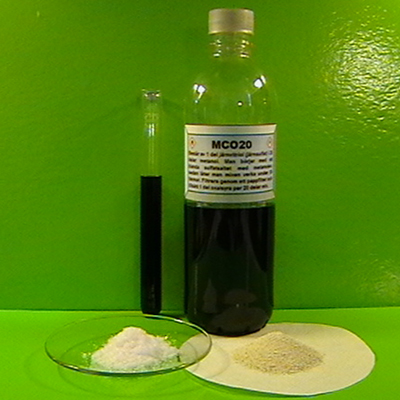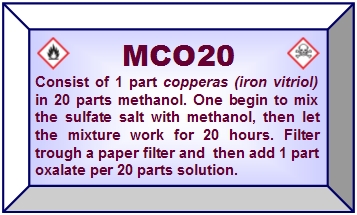Copperas is its trade name and unique in terms of its crystal structure and water content. You can purchase this chemical in almost every paint store - then it's worse with methanol. Methanol was given me by my local speedway club but some hobby shops can sell it. Methanol is toxic and should obviously not be consumed, but one should also avoid getting it on the body when the skin absorbs methanol and it can actually cause serious poisoning if such like an arm is moistened with methanol. Copperas used as an ingredient in Falu red paint and is like oxalic a fairly harmless chemical. I've driven my car at very high levels MCO20 in the fuel without discovering any damage, so I guess it's safe for a car engine. It can be blended into gasoline and E85, but not in diesel - at least not the so-called ”city diesel”.
If one burn MCO20 on a platter, so one can see how it shoots sparks on it. Copperas is converted to iron trioxide, sulfur dioxide and sulfur trioxide when heated above 950 degrees Fahrenheit. Exactly what happens in a car engine is hard to say, but if the formation of iron trioxide occurs it is probably just positive. An iron trioxide coating has a reputation to being catalytic. I have not succeeded in measuring an acid reaction of the residue after torrid MCO20 - for; if iron trioxide formed then formed also sulfuric acid and it should certainly stir up further rusting! In reality, however, transformed residual components (if the environment is moist) in a second step to the iron (III) sulfate - which is alkaline.
The amount of MCO20 in the fuel is relatively high when mixed up with E85. The effect of copperas is most optimal at a sulfate content around 20-25 ppm in the fuel. It exceeds the limit for sulfates by a wide margin because the limit is 4 ppm for E85. I have not been able to find anything negative about the fuel supply, etc. - however, is the positive aspect evident.
Oxalic acid is needed to bind the sulfate. If one skips oxalic acid is the risk high that one may get flocculation of copperas in both the additive and in the fuel. A flocculation in a gas tank may have dramatic consequences because the fuel filter is blocked. If one mix MCO20 with the red glycol occurs, however, flocculation (mostly) - despite the use of oxalic acid ... Oxalic acid also acts as a cleaning additive, because it will dissolve the deposits in the form of metal salts very efficiently - but it also makes sure to tie the pollution so that precipitation will not occur. Oxalic acid is also a reducing agent (fuel).
MCO20:


In the picture you can see an estimated amount of oxalic acid and copperas (right) posted next to a finished batch MCO20. In addition to the description on the label, one can make the mix in a special bottle (eg pet). When 20 hours have passed, one can see that the solution's color is darker than it was from the beginning. It all ends with the filtering (eg a coffee filter), which tend to go quickly and smoothly. In the reservoir which captures the filtrate launch the right amount of oxalic acid. Since oxalic acid is porous and somewhat indefinite in its density can it be difficult to measure some dimensions. Weigh up the amount of oxalic acid or use stroked teaspoons. Add oxalic acid after the copperas is dissolved in methanol - not before! Oxalic acid is readily soluble in methanol.
Included constituents in weight percent:
- 93 % Methanol
- 3.5 % Copperas
- 3.5 % Oxalic acid
The weight oxalic acid in grams = millilitre methanol x 0.026
The use of MCO20 is not free from risks. If you mix MCO20 with red or blue glycol of a cheap/bad brand so is there a precipitate of the sulfate. Any type of precipitation (which is usually preceded by turbidity) corrupts the glycol beneficial effects. For some reason, works only blue glycol of better quality with MCO20. Would you choose distilled glycol, ie completely free of salts - is there not any increase in power. First; test the glycol by adding 1 part MCO20 to 8 parts blue glycol - is there no precipitation after half a day so should it be approved. Unfortunately is there not possible to make any unitary additives (mixtures) of MCO20, blue glycol and acetone - it may look okay at first, but sooner or later there will be a precipitate.
Remember: Never mix G+ with a DiG-additive in a fuel tank! Especially for mixed fuels is this highly inappropriate but for pure E85 is the risk of flocking less.
|
| |
|
| |




